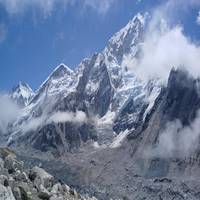How to Find the Best Time to Trek to Everest Base Camp: Seasonal Insights
Walking to Everest Base Camp is a top world trip — and when you go can change the whole trip. The sky, how open you can see, path state, and how many other walkers you find all rely on the ttime you pick. Even though the Himalayas are notable all year, knowing the best and terrible of every season to go will assist you in picking nicely for your goals, ease, and safety.
Let's appearance nearer at what is presented on every occasion has to present so you can plan your stroll properly.
Spring: March to May – Bright, Clear, and Full of Life
Spring is seen as one of the finest times to hike to Everest Base Camp. The sky is obvious, the air is cool, and the flowers bloom brilliantly at the decrease paths. This is when climbers start to go up, making base camp full of life.
In these months, it's still cold up high, more so at night, but day walks are quite comfy. You can see far, getting great views of Everest and other high peaks. It's a liked time, making the paths busy and the stops fun, with many to talk and share tales with.
If you want good weather, views, and a fun vibe — but not the deep cold of winter or the mess of summer — spring is a top pick.
Autumn: Late September to November – Sharp Skies and Golden Paths
Autumn is another great time for the Everest Base Camp walk. After summer rains, the sky is super clear, the air is fresh, and the paths are dry. The hills look extra clear in the light after the rains, and the sights are maybe the best.
It starts to get bloodless up excessively hot, however, it is still bearable with the right clothes. Nights are cold, but days frequently carry loads of solar. It brings back the crowd, but it's not too much. Tea spots are open, stuff is new, and the Khumbu area feels alive after the quiet of the rains.
Autumn is great for those who love photos, with bold colors and strong light that make every view beautiful. This time also has local fests in Nepal, adding more special ffeelingsto the trip.
Winter: December to February – Quiet Paths and Cold Beauty
If you like quiet and do not mind the bloodless, iciness might be for you. Walking in those months gives a special kind of calm and raw beauty. Almost no one is on the paths, the air is sharp, and snowy hills look amazing under a clear winter sky.
But it's tough. Night temps up high can fall a lot, and snow can block parts of the path or make them hard to walk. Some stops close for the time, so you'll need to plan your stays well. But the open spots are cozy and friendly, with fewer folks and more care.
Winter walking is best for those who know the cold and like being on their own.
Monsoon: June to Mid-September – Green but Tough
The monsoon time is not a key time for walking to Everest Base Camp — and with clear cause. The area gets a lot of rain, making paths muddy, slick, and more likely to fall. Clouds often hide the hills, and bugs are a bother in forest zones.
Flights to Lukla are often late or not flying due to bad weather, and walking the path is more hit or miss. But for the truly daring and slightly stubborn) There are still good parts. The rain grows a lot of green plants and wildflowers. The paths are empty, and you can always find a place to stay.
If you don't mind mud and missing the views for green views, the monsoon might offer a more of trip.
Final Thoughts: Timing Is Part of the Trip
No matter when you go, the Everest Base Camp walk is a thing you'll always recall. The time changes what you'll see and feel, but each time has something special — be it the wildflowers of spring, the fests of autumn, the quiet of winter, or the lushness of the monsoon.
So think not just of when it's easy — think of when it's right for you. Walking to Everest Base Camp isn't just moving through space. It's a trip through time, culture, and yourself. Pick your time, and make it yours.
